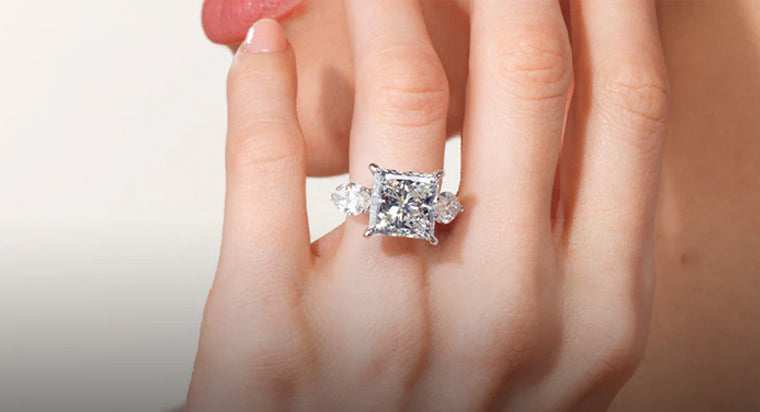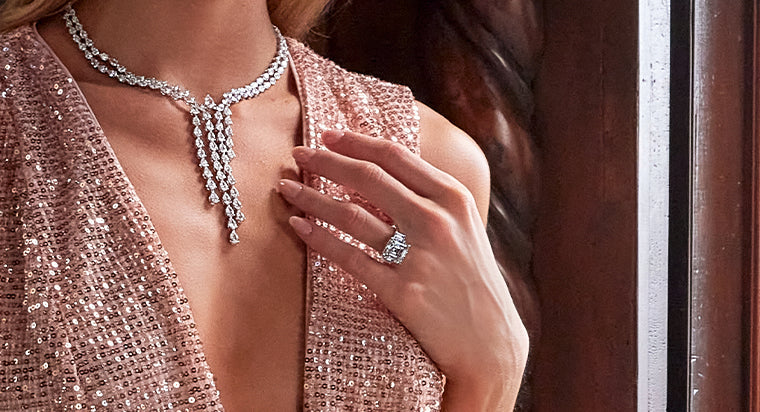Buying Guide for Radiant Engagement Rings

A Radiant-cut diamond might not be as familiar as a Round cut diamond or Princess cut diamond. It combines the elegance of an Emerald cut with the dazzling sparkle of a Round brilliant. Its cropped corners and 70 facets ensure exceptional fire and brilliance. Radiant cuts have an edgier look that still looks elegant. They look amazing in diamond jewelry, especially engagement rings where the diamond is the focal point.
TABLE OF CONTENTS
So, What Is a Radiant Cut Anyway?
Radiant cuts might be less familiar, as they're a relatively newer option. Henry Grossbard created the Radiant cut diamond in 1977. His goal was to create a diamond cut that combined the brilliance of a Round diamond with the sleek look of an Emerald or Asscher cut diamond. It's perfect for couples who like the elegance of a step-cut diamond but want the intense sparkle of a Round brilliant.
Like emerald-cut diamonds, radiant cuts can vary in shape—some appear more rectangular, while others look more square. Their 70 facets and unique shape help hide inclusions and can mask lower color quality. A popular choice for engagement rings for their classic shape and stunning sparkle.
Why Choose a Radiant Engagement Ring?
Round brilliant diamonds have 58 facets, and Radiant diamonds have 70. Those extra facets provide excellent brilliance. Many couples like that the shape is both edgy and modern, yet soft. Its versatility makes it a stunning choice for a wide range of personal styles - from minimalist to glam. Couples also appreciate that this cut hides flaws better than other shapes, so you can get a gorgeous diamond without upgrading the quality. It's also suitable for active styles because the beveled corners aren't as delicate as pointed versions found in other cuts.
What to Look for When Shopping
Cut is crucial for most diamonds and applies to Radiant cut diamonds. You want a symmetric stone so the shape and corners look balanced. The length-to-width ratio also affects the overall look. You can go with 1.20 to 1.35 if you'd like a more rectangular shape. Look for length-to-width ratios in the 1.0 to 1.05 range if you'd prefer a more square-looking cut. Radiant cuts hide inclusions well, so you don't have to look for diamonds with a higher clarity grade. They also mask color better than other diamond cuts, like Emeralds or Ovals, so you don't have to get a colorless grade to get a gorgeous-looking diamond. You can also consider a lab-grown diamond rather than a natural diamond. They're sustainable, ethically sourced, and often more affordable. More couples opt for lab diamonds to get a diamond that reflects their values.
Setting Styles That Work Best
Radiant cuts fit with a variety of engagement ring settings. It's a beautiful, versatile stone. Solitaire remains a classic choice because the diamond can be the star of the ring. Halos add sparkle to the ring by surrounding the center of the Radiant-cut with a diamond border. Pairing a halo setting makes a glamorous-looking ring. You can also go with a pavé band if you'd like some extra sparkle but still want the focus on the Radiant diamond. Consider a three-stone diamond ring if you want to go in another direction. You can choose subtle side stones like tapered baguettes or smaller diamonds that let the center stone stand out. You have plenty of options for three-stone rings! The hidden halo is a newer engagement ring setting, where a diamond ring is hidden just below the center diamond. It's a subtle detail you can see when you wear your stunning ring.
Wrapping Things Up
Radiant-cut diamond engagement rings aren't as commonly known as other diamond cuts, but they make diamond jewelry sparkle. With 70 facets, radiant stones combine an Emerald-cut diamond's elegance with a Round diamond's brilliance. Their unique combination also works well in various settings, from solitaire to hidden halos. You can level up the brilliance with a halo setting or keep it classic with a solitaire. This cut conceals inclusions and softens color, allowing you to choose lower clarity and color grades without compromising on beauty. Cut is important, so you'll want to closely examine the symmetry and length-to-width ratio of any of the diamonds you're considering. If you'd like to save more and get a diamond that reflects sustainability, consider a lab diamond for your engagement ring.
Summary
Radiant-cut diamond engagement rings blend Emerald-cut elegance with brilliant sparkle. Featuring 70 facets and beveled corners, they offer exceptional fire, hide flaws well, and suit various settings like solitaires, halos, and three-stone designs. Their versatility and bold style appeal to modern couples. These diamonds are also a sustainable, budget-friendly option. This guide by With Clarity helps you explore symmetry, cut quality, and ideal settings for Radiant-cut diamonds to find the perfect engagement ring.
FAQs
Are Radiant cuts sparkly?
Is a Radiant cut more expensive than other shapes?
Do Radiant cuts look bigger?
Can I go for a lab-grown diamond?
What engagement ring setting works best with Radiant cuts?










